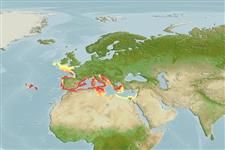>
Gadiformes (Cods) >
Moridae (Morid cods)
Etymology: Eretmophorus: Greek, eretmos, -ou = with oars + Greek pherein = to carry (Ref. 45335).
Environment: milieu / climate zone / depth range / distribution range
पारिस्थितिकी
समुद्री बेनथोपिलाजिक; गहराई सीमा 30 - 500 m (Ref. 48606). Temperate
Mediterranean Sea: Ligurian Sea, Tyrrenian Sea, Strait of Messina. Possibly in the North subtropical Atlantic.
आकार / वज़न / Age
Maturity: Lm ? range ? - ? cm
Max length : 8.9 cm SL पुल्लिंग / अलिंग; (Ref. 48606)
Perhaps the early stage of a known species of Moridae, or else neotenic (Ref. 4774).
Life cycle and mating behavior
परिपक्व अवधि | पुनरुत्पत्ति | मछलीऔ का अंडे देना | अंडे | Fecundity | लार्वा
Cohen, D.M., 1986. Moridae. p. 713-723. In P.J.P. Whitehead, M.-L. Bauchot, J.-C. Hureau, J. Nielsen and E. Tortonese (eds.) Fishes of the north-eastern Atlantic and the Mediterranean, Volume 2. Unesco, Paris. (Ref. 4774)
IUCN Red List Status (Ref. 130435)
Threat to humans
Harmless
Human uses
मात्स्यिकी: कोई रुचि बग़ैर
अधिक जानकारी
आम नामउपशब्दचपायचयपरभक्षीईकोटोकसीकोलौजीपुनरुत्पत्तिपरिपक्व अवधिमछलीऔ का अंडे देनाSpawning aggregationFecundityअंडेEgg development
Age/Sizeबाढ़Length-weightLength-lengthLength-frequenciesमौरफोमैटरिक्सआकृति विज्ञानलार्वालारवल गतिकीभर्तीबहुतायतBRUVS
संदर्भजलीयकृषिजलीयकृषि रूपरेखाखींचआनुवंशिकीElectrophoresesहैरेटिबिलटीबीमारीप्रक्रमणNutrientsMass conversion
सहयोगीयोतस्वीरेStamps, Coins Misc.ध्वनिसिगुयटिरारफ्तारतैरने के प्रकारगिल क्षेत्रOtolithsदिमागदृष्टि
साधन
Special reports
Download XML
इंटरनेट स्रोत
Estimates based on models
Preferred temperature (Ref.
123201): 11.3 - 15.3, mean 13.7 °C (based on 86 cells).
Phylogenetic diversity index (Ref.
82804): PD
50 = 1.0000 [Uniqueness, from 0.5 = low to 2.0 = high].
Bayesian length-weight: a=0.00389 (0.00195 - 0.00776), b=3.11 (2.93 - 3.29), in cm total length, based on LWR estimates for this (Sub)family-body shape (Ref.
93245).
Trophic level (Ref.
69278): 3.4 ±0.45 se; based on food items.
लौटाव (Ref.
120179): ऊंचा, न्यूनतम जनसंख्या दुगनी समय अवलागत 15 महीने। (Preliminary K or Fecundity.).
Fishing Vulnerability (Ref.
59153): Low vulnerability (10 of 100).
Nutrients (Ref.
124155): Calcium = 70.5 [36.9, 166.6] mg/100g; Iron = 0.421 [0.231, 0.853] mg/100g; Protein = 16.4 [14.7, 18.1] %; Omega3 = 0.497 [0.210, 1.052] g/100g; Selenium = 14.6 [6.0, 36.0] μg/100g; VitaminA = 69.1 [15.9, 292.3] μg/100g; Zinc = 0.9 [0.6, 1.4] mg/100g (wet weight);
